Related Research Articles
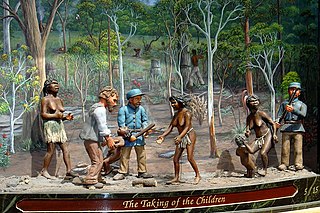
The Stolen Generations were the children of Australian Aboriginal and Torres Strait Islander descent who were removed from their families by the Australian federal and state government agencies and church missions, under acts of their respective parliaments. The removals of those referred to as "half-caste" children were conducted in the period between approximately 1905 and 1967, although in some places mixed-race children were still being taken into the 1970s.

The history of Australia is the story of the land and peoples of the continent of Australia.
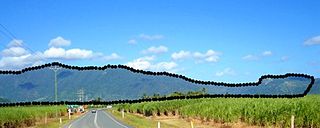
Australian Aboriginal religion and mythology is the sacred spirituality represented in the stories performed by Aboriginal Australians within each of the language groups across Australia in their ceremonies. Aboriginal spirituality includes the Dreamtime, songlines, and Aboriginal oral literature.
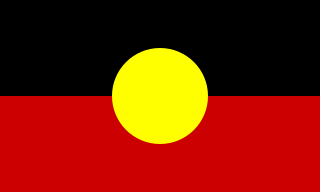
The Australian Aboriginal Flag represents Aboriginal Australians. It is one of the officially proclaimed flags of Australia, and has special legal and political status together with the national flag and the Torres Strait Islander Flag, with which it is often flown.
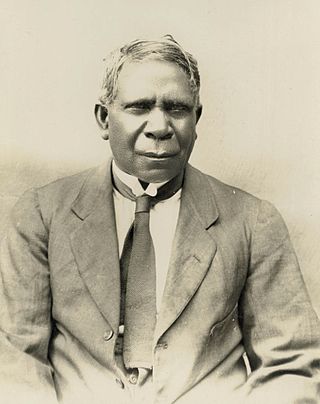
David Ngunaitponi, known as David Unaipon, was an Aboriginal Australian preacher, inventor and author. He was a Ngarrindjeri. Unaipon's contribution to Australian society helped to break many Aboriginal Australian stereotypes, and he is featured on the Australian $50 note in commemoration of his work. He was the son of preacher and writer James Unaipon.
Native title is the designation given to the common law doctrine of Aboriginal title in Australia, which is the recognition by Australian law that Indigenous Australians have rights and interests to their land that derive from their traditional laws and customs. The concept recognises that in certain cases there was and is a continued beneficial legal interest in land held by Indigenous peoples which survived the acquisition of radical title to the land by the Crown at the time of sovereignty. Native title can co-exist with non-Aboriginal proprietary rights and in some cases different Aboriginal groups can exercise their native title over the same land.

Norman Barnett Tindale AO was an Australian anthropologist, archaeologist, entomologist and ethnologist.

Aboriginal Australians are the various First Nations peoples of the Australian mainland and many of its islands, such as the peoples of Tasmania, Fraser Island, Hinchinbrook Island, the Tiwi Islands and Groote Eylandt, but excluding the ethnically distinct Torres Strait Islands. The term Indigenous Australians refers to Aboriginal Australians and Torres Strait Islanders collectively.
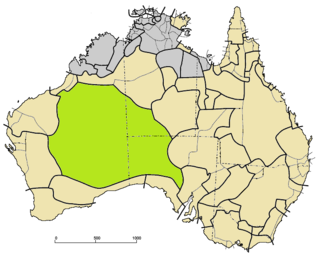
The Western Desert language, or Wati, is a dialect cluster of Australian Aboriginal languages in the Pama–Nyungan family.

North Queensland or the Northern Region is the northern part of the Australian state of Queensland that lies just south of Far North Queensland. Queensland is a massive state, larger than many countries, and its tropical northern part has been historically remote and undeveloped, resulting in a distinctive regional character and identity.
Ngarrindjeri, also written Narrinyeri, Ngarinyeri and other variants, is the language of the Ngarrindjeri and related peoples of southern South Australia. Five dialects have been distinguished by a 2002 study: Warki, Tanganekald, Ramindjeri, Portaulun and Yaraldi.

The history of Indigenous Australians began at least 65,000 years ago when humans first populated the Australian continental landmasses. This article covers the history of Aboriginal Australian and Torres Strait Islander peoples, two broadly defined groups which each include other sub-groups defined by language and culture.
The voting rights of Indigenous Australians became an issue from the mid-19th century, when responsible government was being granted to Britain's Australian colonies, and suffrage qualifications were being debated. The resolution of universal rights progressed into the mid-20th century.
Indigenous Australians are people with familial heritage from, and membership in, the ethnic groups that lived in areas within the Australian continent before British colonisation. They consist of two distinct groups: the Aboriginal peoples of the Australian mainland and Tasmania, and the Torres Strait Islander peoples from the seas between Queensland and Papua New Guinea. The term Aboriginal and Torres Strait Islander peoples or the person's specific cultural group, is often preferred, though the terms First Nations of Australia, First Peoples of Australia and First Australians are also increasingly common; 812,728 people self-identified as being of Aboriginal and/or Torres Strait Islander origin in the 2021 Australian Census, representing 3.2% of the total population of Australia. Of these Indigenous Australians, 91.4% identified as Aboriginal; 4.2% identified as Torres Strait Islander; while 4.4% identified with both groups. Since 1995, the Australian Aboriginal flag and the Torres Strait Islander flag have been official flags of Australia.
The Aboriginal Heritage Act 1988 (AHA) is the principal South Australian legislation protecting and preserving the state's Aboriginal heritage. It repealed and replaced the Aboriginal and Historic Relics Preservation Act 1965, which was the first state legislation to protect Aboriginal Australian heritage in Australia.
Land councils, also known as Aboriginal land councils, or land and sea councils, are Australian community organisations, generally organised by region, that are commonly formed to represent the Indigenous Australians who occupied their particular region before the arrival of European settlers. They have historically advocated for recognition of traditional land rights, and also for the rights of Indigenous people in other areas such as equal wages and adequate housing. Land councils are self-supporting, and not funded by state or federal taxes.

The Australian frontier wars were the violent conflicts between Indigenous Australians and non-Indigenous settlers during the colonisation of Australia. The first conflict took place several months after the landing of the First Fleet in January 1788, and the last frontier conflicts occurred in the early 20th century, with some occurring as late as 1934. An estimated minimum of 100,000 Indigenous Australians and between 2,000 and 2,500 settlers died in the conflicts. Conflicts occurred in a number of locations across Australia.
Indigenous land rights in Australia, also known as Aboriginal land rights in Australia, are the rights and interests in land of Aboriginal and Torres Strait Islander people in Australia; the term may also include the struggle for those rights. Connection to the land and waters is vital in Australian Aboriginal culture and to that of Torres Strait Islander people, and there has been a long battle to gain legal and moral recognition of ownership of the lands and waters occupied by the many peoples prior to colonisation of Australia starting in 1788, and the annexation of the Torres Strait Islands by the colony of Queensland in the 1870s.
References
- ↑ Clarke, Phillip (19 February 1996). "THE ABORIGINAL COSMIC LANDSCAPE OF SOUTHERN SOUTH AUSTRALIA" (PDF). Division of Anthropology, South Australian Museum. Retrieved 22 June 2017.